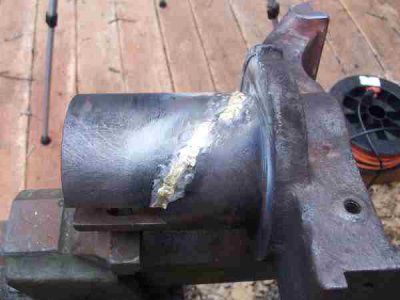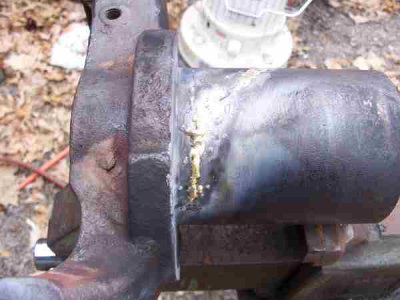Boy the welding and casting forum is slow. This thread is still at the top of the stack.
It's been 10 days since I posted this thread and I finally got around to brazing the vice.
I'm happy with the results, but they could have been better. To begin with I couldn't find my large welding tip. I could only find the small one. So I tried using the small one on the screw repair behind the vice jaw. First I heated the whole thing up over a wood fire. I don't know how hot it was but it was so hot I couldn't even hang onto it very long with brand new welding gloves on. I did manage to braze up the broken jaw screw hole. But it was going way to slow with that small tip, and I didn't like the way it was flowing. So when I moved on to welding up the crack I used my 4-burner cutting torch to braze with.

That worked way better. In fact it worked absolutely beautiful for the first half of the crack. The braze rod was getting sucked into the crack like a vacuum cleaner. Very good deep brazing. And the top of the brass was nice and flat, almost perfectly flush with the top surface. and not even sunken in. But then I had to stop and turn the piece in the vice to braze up the second half of the crack. I didn't stop for long only long enough to readjust the workpiece in the vice. But then I couldn't seem to get it hot enough to really suck in the brass after that. I tried to be patient and waiting for it to get as hot as I could get it, but despite my best attempts the whole rest of the brazing job was a real fight with trying to get the brass to flow nice. It tended to ball up and not want to wet out. I was having so much trouble I even stopped and hit the thing with a wire brush. But that didn't help.
I did manage to lay down some brass on the second half of the crack, and some places wetted-out better than others. Overall I'm ok with the finished brazing. The worst part of the crack took the brass really well. So that was the more important part I think. In any case, I'm going to let it be and move on to just cleaning it up and putting it back together.
This is the good side of the brazing job. Not sure what it looks like in the photo, but it looks really good in person.

This is the bad side of the brazing job. Can't see it very well with the sun shining on it. But it definitely looks amateur with a few balls above the surface. I just couldn't get those balls to wet in. It's not all bad, there were places where it flowed better than others. I'm thinking that it was because I was getting close to the massive vice head and that was sucking up all the heat? I think I could have done better if I could have found my bigger torch. Even my four burner cutting torch isn't all that hot, but it did work.

So now I'm ready for the clean up stage and the reassembly of the vice.
If I had done this for a customer I'd be ashamed to ask money for it.

Like I say, the first half was beautiful. Looked and felt professional. But the second half petered out and made me look like an idiot. I think it will hold though and that's good enough for me. I just blame it on the missing large torch.





